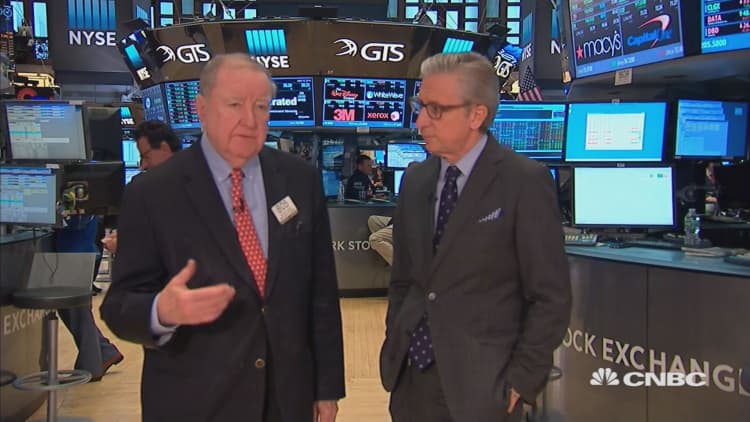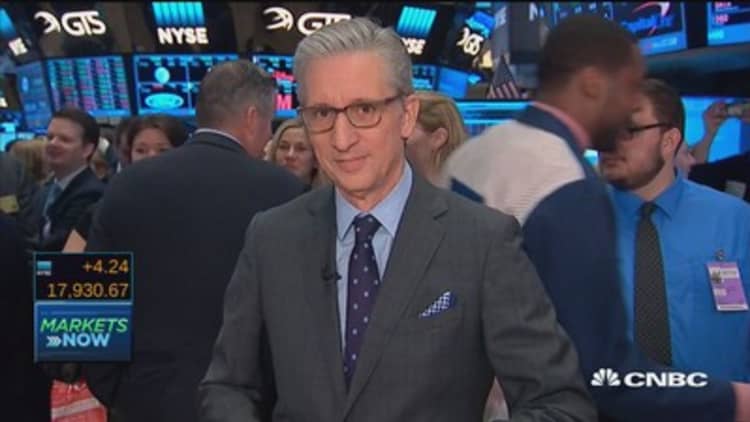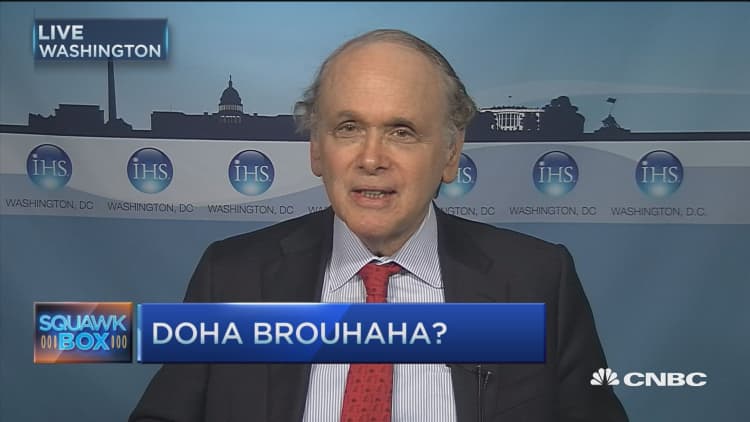


U.S. stocks closed lower Friday, with energy stocks leading declines as oil prices fell ahead of a highly anticipated weekend meeting of oil producers.
The Dow Jones industrial average closed about 29 points lower on the day but gained 1.82 percent for the week, its best since the week ended March 18. (Tweet This)
Energy closed 1.26 percent lower to lead S&P 500 decliners, followed by information technology.
U.S. crude oil futures settled down $1.14, or 2.75 percent at $40.36 a barrel. Earlier, Baker Hughes said the weekly oil rig count fell 3 to 351.
Oil producers led by top exporters Saudi Arabia and Russia plan to meet Sunday in Doha, Qatar, to discuss freezing output around current levels in an effort to contain a global supply glut.
"I'm not expecting a lot out of it. They could agree loosely to freeze production at January levels, but that was record levels," said Lee Ferridge, head of macro strategy, North America, State Street Global Markets.
Read MoreA Doha deal could keep lifting prices: CNBC Oil Survey
Apple closed 2 percent lower following a Nikkei report the iPhone maker will continue reduced production of the device from April to June in light of sluggish sales, according to a parts supplier notified of the plan.
Apple and Goldman Sachs contributed the most to declines in the Dow.
The major averages closed off session lows but remained under pressure, after earlier attempting slight gains. On Thursday, the Dow and S&P 500 closed at their highest levels of the year so far.
"Overall it's a pretty soggy environment for the market as the week wraps up here," said David Kelly, chief global strategist at JPMorgan Funds. "We got some good Empire manufacturing numbers but the industrial production is pretty crummy."
We're in "something of a vacuum," he said. "There's no real news. The economy is really struggling here but there's nothing alarming."
U.S. economic news was mixed, with the Empire State Manufacturing Survey rising nine points in April to 9.6, its highest in more than a year, while industrial production fell a more-than-expected 0.6 percent in March. Capacity utilization also declined to 74.8 percent, the lowest level since August 2010, Reuters said.
The preliminary consumer sentiment for April was 89.7, missing expectations for a slight rise to March's final read of 91.
Citigroup posted first-quarter earnings per share of $1.10, falling 27 percent from $1.51 a share in the year-earlier period. Revenue for the quarter came in at $17.55 billion, against the comparable year-ago figure of $19.81 billion. However, both earnings and revenue topped expectations. The stock gave up initial gains to close 0.13 percent lower.
Financials snapped a five-day win streak with a 0.29 percent decline, but held weekly gains of nearly 4 percent as the top sector for the week. Year-to-date, financials remains the worst performing S&P sector.
"The financials (have) been the real story of the week, significant moves off the lows," said Art Hogan, chief market strategist at Wunderlich Securities.
"What's really positive is on the risk-on days you've seen outperformance on the oversold groups," he said.
U.S. stocks closed narrowly mixed Thursday. The Dow and S&P 500 squeezed out gains, with the Dow ending at its highest since July 20, 2015, and the S&P at its highest since Dec. 4.
As of Friday's close, both indexes were about 2.5 percent below their 52-week intraday highs.
"To some extent the bar on earnings are so low market participants believe companies will continue to beat them. My view is if we run up to the tops of last May it will have a hard time going through those tops given the economic trends," said Chuck Self, CIO of iSectors. He noted some disappointing data on retail sales, capacity utilization and unemployment in recent weeks.
In other corporate news, Bats Global Markets made its second attempt at an initial public offering, pricing its IPO late Thursday at $19 a share, the high end of the expected range. The company's previous IPO attempt four years ago failed due to technical issues. The stock jumped 21 percent in its first day of trade.
Friday also marked options expiration.
Chicago Fed President Charles Evans said in a Dow Jones report that recent inflation numbers are better but could be transitory. He also said continuation of a "wait and see approach" is appropriate for the Federal Open Market Committee.
Treasury yields held lower, with the near 0.73 percent and the 10-year yield at 1.75 percent.
The U.S. dollar index was slightly lower, with the euro near $1.128 and the yen at 108.73 yen against the greenback.
Major U.S. Indexes
Global stocks closed lower but ended the week with solid gains. The German DAX closed about 0.4 percent lower, holding a weekly gain of almost 4.5 percent. The Nikkei 225 gained nearly 6.5 percent for the week and the Shanghai composite rose 3.1 percent for the week.
Overnight, official data showed China's gross domestic product grew at an annual rate of 6.7 percent in the first quarter, a touch below the fourth-quarter's 6.8 percent rate.
Other data topped expectations. Retail sales edged up to 10.5 percent in March, while fixed-asset investment growth rose to 10.7 percent year-on-year in the first quarter, Reuters said. Industrial output growth jumped to 6.8 percent from 5.4 percent.
Total social financing rose to 2.34 trillion yuan ($360.78 billion) in March from 780.2 billion yuan in February, Reuters said.
Read MoreEarly movers: RF, PLCM, BATS, FL, MU, SEAS, VRX, COST, VIAB & more
The Dow Jones industrial average closed down 28.97 points, or 0.16 percent, at 17,897.46, with Apple leading decliners and Travelers Cos. the top advancer.
The index rose 1.8 percent for the week, with JPMorgan Chase the top performer and Coca-Cola the worst.
The closed down 2.05 points, or 0.10 percent, at 2,080.73, with energy leading five decliners and utilities the top advancer.
The S&P rose 1.6 percent for the week, with financials were the best performer and consumer staples the worst.
The Nasdaq composite closed down 7.67 points, or 0.16 percent, at 4,938.22.
The Nasdaq gained 1.8 percent for the week, with Apple up 1.1 percent and the iShares Nasdaq Biotechnology ETF (IBB) rising nearly 1.2 percent.
The CBOE Volatility Index (VIX), widely considered the best gauge of fear in the market, edged lower to near 13.7.
About eight stocks advanced for every seven decliners on the New York Stock Exchange, with an exchange volume of 992 million and a composite volume of 3.6 billion in the close.
High-frequency trading accounted for 49 percent of April's daily trading volume of about 6.99 billion shares, according to TABB Group. During the peak levels of high-frequency trading in 2009, about 61 percent of 9.8 billion of average daily shares traded were executed by high-frequency traders.
Gold futures for June delivery settled up $8.10 at $1,234.60 an ounce.






